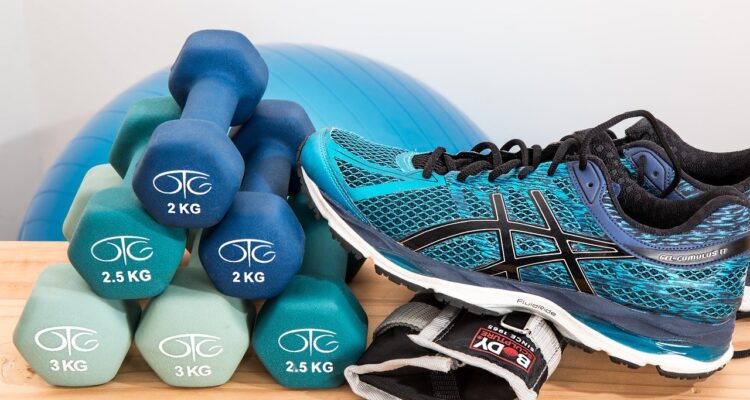
A well-designed exercise routine should contain 3 types of exercises, and if you are older or have balance difficulties, then add the 4th type.
- Cardio: Endurance or aerobic exercise improves cardiovascular fitness and capacity to do work. This is the form of exercise that helps prevent diseases like heart disease, dementia and diabetes the most!
- Strength: Weight or resistance training improves muscular fitness and ability to do physically demanding tasks. It makes your muscles and bones stronger and increases metabolism.
- Stretching: Flexibility exercise improves range of motion and posture. It helps prevent injuries and back pain.
- Balance: Balance training improves coordination and agility. It helps to prevent falls and improves mobility.
When starting an exercise program or new exercise remember to ease into it to prevent injury and/or Delayed Onset Muscle Soreness (DOMS) [i]. If you plan to start jogging 30 minutes a day, then start with brisk 10-minute walk daily and add 5 minutes every week until you get to 30 minutes comfortably. Next add some jogging in for 5 of the 30 minutes increase the jog time 5 minutes every few weeks until you get to your goal. No rush just a calculated game plan to continue to make progress to achieve a goal. If you jump in all at once you may suffer an injury or DOMS causing frustration and possibly quitting all together. Your body can only improve so fast and pushing it beyond will not necessarily speed the improvement but will not allow it time to recover properly before the next training session and lead to a suboptimal outcome.
Everyone is different and finding the training activities that fit your abilities and the ones you enjoy enough to continue are keys to long-term success. Discipline will only get you so far if you are going against the grain. Running is not better than walking if you give up the running because it is too demanding on your joints or muscles. Going from sitting to walking is a lot more than walking to running when it comes to improving your health. And yes, you can go too far, too fast and too hard creating burnout or a crash.
Also, if you have a weak area you may want to put a little more time or focus there but remember the exercise types are not mutually exclusive. If your strength training leads to stronger legs, abdomen and back then your balance will improve. If you improve your flexibility you will find your cardio and strength performance will get better. Young people may not have to do balance training since there lifestyles are typically more active and dynamic to provide it for them. Lifestyles tend to slow down with age and become less active making exercise more important the older we become. There is no such thing as too old to exercise. Studies show that even octogenarians can gain muscle, become stronger, improve flexibility and improve physical performance by adding exercise training.
My Basic Recommendation
Cardio
- Get a sustained (15 minutes minimum per session) amount of aerobic activity at least three days a week. Note: If you are going to exercise only three days a week do not make them consecutive days.
- Get a total of 150 minutes of moderately intense activity (3-6 METs) OR 75 minutes of vigorously intense activity (more than 6 METs) [ii].
- Activities requiring 3-6 METs: Brisk walking, water aerobics, ballroom/social dancing, gardening and leisurely cycling slower than 10 miles an hour.
- Activities requiring 6 or more METs: Hiking uphill, running, swimming laps, aerobic dancing, jumping rope, heavy yardwork like digging and cycling 10 miles per hour or faster.
- If you are using heart rate (HR) to determine activity level, then moderately intense HR is 60-75% of your maximal heart rate (MHR) and vigorously intense is done at 76-93% MHR.
- If you are younger than 40 then use the classic estimate: MHR = 220 – Age.
- If you are over 40 then the Tanaka estimate: MHR = 208 – (0.7 x Age) is more accurate.
Strength
- At least two days a week with at least one day between training sessions to allow proper recovery.
- Target major muscles groups: Arms, shoulders, chest, back, abdomen, thighs and calves with 1-2 exercises each.
- Do 1-2 sets of 8-15 repetitions. When able to do 15 reps comfortably through the full range of motion then go up in weight 5-10%.
Flexibility
- At least two to three days a week (daily stretching provides max benefit).
- Best done after aerobic or resistance training [iii].
- Perform 1-2 sets for 30-120 seconds of static and/or dynamic stretching for all major body movements/joints. Adding midsize and small joints as we age is also beneficial.
- Within 3-4 week of starting a stretching program one should start to realize the benefits.
Balance
- At least two days a week and the more days the better.
- Target at least 2 hours a week.
- Tai Chi and Yoga is a form of balance training along with strength and flexibility benefits.
- Focus your strength training on the core muscles (pelvis, back and abdomen) and legs (hamstrings, glutes and hip flexors) to improve your balance.
Now armed with the basic outline of a comprehensive exercise design, you can go proceed to build a better future health!
Notes:
[i] Muscle stiffness and soreness that often starts hours after strenuous and peaks 24-72 after the exercise. It is more severe than the mild soreness that comes regularly with adapting to a new exercise or training regime. It is believed due to microtears in the muscles and the inflammatory response to repair the damage. It is a perfectly normal response to excessively loading muscles beyond the normal routine.
[ii] MET: Metabolic Equivalent of Task. One MET is the amount of energy a person burns sitting quietly measured by oxygen consumption per weight per minute. It measures the amount of cardiovascular work that is being done.
[iii] Stretching before exercise does not prevent injury. Warming up before does and adding stretching with the warm-up may improve performance. Warm-up (with or without stretching) before and stretch after is the rule.



